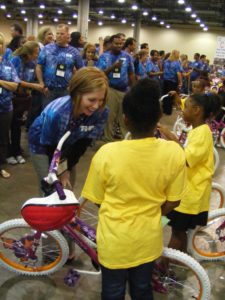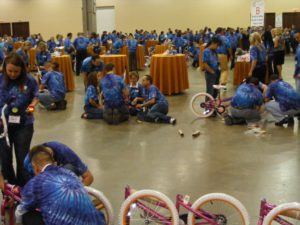 The Build-A-Bike ® team building activity was such a big hit. Most people think that everything went perfectly in the beginning. But we made a BUNCH of mistakes early on. I believe that learning from these mistakes made us the success that we are today, though. Most team building event companies aren’t going to tell you about the times they screwed things up. (Typically, we wouldn’t either.) However, we feel that by sharing our goof-ups with you, it will keep you from making the same mistakes. So, if you are organizing you own team building activity, learn from our experience.
The Build-A-Bike ® team building activity was such a big hit. Most people think that everything went perfectly in the beginning. But we made a BUNCH of mistakes early on. I believe that learning from these mistakes made us the success that we are today, though. Most team building event companies aren’t going to tell you about the times they screwed things up. (Typically, we wouldn’t either.) However, we feel that by sharing our goof-ups with you, it will keep you from making the same mistakes. So, if you are organizing you own team building activity, learn from our experience.
Biggest Mistakes #1: Too Much Time on My Hands
As a trainer, I realized that the shorter the training time period, the less content we could cover. Since we started as a training company centered on “behavior change”, we always encouraged our clients to spend a lot of time in the training process. It just makes sense. A 12 week seminar series will get you much better results than a one-hour workshop. However, when we first created Build-A-Bike ®, we realized early on that the purpose or result expected was quite different than we were expecting. The reason why Build-A-Bike ® became so popular, so fast was two-fold. First, it was a fantastic way to build teamwork and build a community. Secondly, though, it was a fantastic way to take dry content or boring meetings and add an enormous amount of energy and positive emotion.
Early on, though, since we were trainers, we did a lot of teaching in the programs. It worked really well for the smaller groups. It was a great balance between good content and good fun. As group sizes increased, though, we realized that the longer the event went on, the less energy the group generated. Over the last decade and a half, we have discovered the “sweet spot” for length of time. The ideal team building activity time-frame is 1.5 hours to 2.5 hours. If the group is larger than 100 people, we recommend a max 1.5 hour time-frame.
Lessons Learned
With all that being said, we have also found great value in conducting what we call a “combo” program. These events begin with a few hours of fun classroom training. Then, we take a short break and conclude with a Build-A-Bike ® event.
Biggest Mistakes #2: Building the Charity Event for the Charity
This mistake was the one that caused the most challenges along the way. In the first few Build-A-Bike ® events, we contacted charities and asked them to pick kids for us who would benefit from receiving a new bike. This backfired very quickly. The first event was flawless, because the charity gave us kids who were all about the same age (6 to 8 years-old). For the second event, we asked the Campfire organization in Ft. Worth to pick kids for us. Since this program ended in the middle of the day, though, the Campfire Director brought a photo-album with her. This album contained photographs of each kid who would receive a bike. She went from group to group telling each team about their kid. That one went flawlessly as well.
The problem erupted when I taught the third event. This event was for Wells Fargo in Anchorage, Alaska… in January. Wells Fargo had a relationship with the Salvation Army, so they wanted to donate the bikes there. That part wasn’t the problem. We can donate to any charity. However, The Salvation Army picked children who ranged in age from five years-old to 13 years-old. So, we had to acquire a vast array of different bikes sizes and styles in January… in Anchorage, Alaska. We got it done, but it was extremely challenging. I still remember the look on the 13 year-old girl who received the adult size bike at the end of the program. I think she was mortified. Thirteen-year-old girls don’t tend to get excited when they receive a new bike.
Lessons Learned
By the way, because the adult bikes have gears and handbrakes, they were much more difficult to assemble. So, the unintended consequence of this mistake was that some of the teams finished very quickly. Some finished 20 to 30 minutes later. From that point, we started asking the charities to pick kids for us who were six to nine years-old. The bikes are easier to assemble, and the kids are more excited.
Biggest Mistakes #3: What Works for One Works for All
 This mistake was, by far, the most embarrassing. The first 100 or so Build-A-Bikes ® that we delivered were all for groups from 20 people to 100 people in size. Everything was more expensive back then because we were purchasing all of our materials at retail. As a result, if a group size was under 20 people, it typically wasn’t very cost effective. Also, if the group was only build two bikes, it was kind of anti-climactic. So, we created a separate event for smaller group. We wouldn’t even quote a Build-A-Bike ® for smaller groups.
This mistake was, by far, the most embarrassing. The first 100 or so Build-A-Bikes ® that we delivered were all for groups from 20 people to 100 people in size. Everything was more expensive back then because we were purchasing all of our materials at retail. As a result, if a group size was under 20 people, it typically wasn’t very cost effective. Also, if the group was only build two bikes, it was kind of anti-climactic. So, we created a separate event for smaller group. We wouldn’t even quote a Build-A-Bike ® for smaller groups.
In 2007, though, we had what could have been the biggest failure ever had it not been for the fantastic skill of our instructors. We were hired to conduct a Build-A-Bike ® event for 800 people. No one had ever done anything like this before. We were very confident, though. By that point we had conducted hundreds of events, and each of them was an overwhelming success. We had a set series of activities that worked really well. So, we organized this huge 800 person event by creating 12 separate groups — each with a different instructor. We had a stage in the center of the room, and I was the emcee. The plan was to have me speak to the entire group, give instructions, and then have each instructor in each group take over. It didn’t workout that way though.
The Best Laid Plans
We setup the event in a ballroom with a concrete floor and a huge open space (think empty trade show area). We setup a stage in the middle of the room. The event planner decided to setup four speakers, one at each corner of the stage, facing out. We separated the venue into 12 distinct sections, and the room looked beautiful. It was an amazing sight. We did a sound-check earlier in the day, and it was perfect. We were all so excited.
However, the participants arrived, and when 800 people started milling around and chatting, the noise level increased exponentially. In addition, because of the concrete floor, the sound ECHOED. I began speaking, and immediately I started getting reports that the people farthest away from the speakers couldn’t hear anything. So, I spoke louder. When I did, I saw the people closer to me cringe. Eventually, we ended up just skipping all of the introductions and instructions. Each facilitator ended up screaming instructions to their 80 or so people. It turned out okay, but we learned a lot of lessons.
Lessons Learned
The main takeaway from that challenge was that some activities are great for smaller groups and some are great for bigger group. Very few work for both. We redesigned all of our events after that program. Today, the activities that we do for a group of 25 people are totally different from the ones that we use for 150 people.
Learn from Our Mistakes
Over the years, we have seen it all. We’ve made every mistake in the book. When we make these mistakes, though, we find ways to make sure those mistakes never happen again. Remember that anything you do for the first time is an experiment. So if you want a flawless team building activity, hire a team building company who has a lot of experience. You can reach one of our experts by dialing (800) 872-7830!
